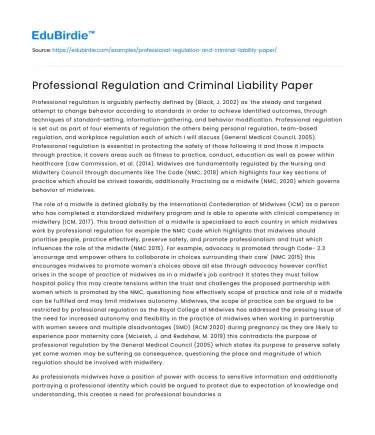Professional regulation is arguably perfectly defined by (Black, J. 2002) as 'the steady and targeted attempt to change behavior according to standards in order to achieve identified outcomes, through techniques of standard-setting, information-gathering, and behavior modification. Professional regulation is set out as part of four elements of regulation the others being personal regulation, team-based regulation, and workplace regulation each of which I will discuss (General Medical Council, 2005). Professional regulation is essential in protecting the safety of those following it and those it impacts through practice, it covers areas such as fitness to practice, conduct, education as well as power within healthcare (Law Commission, et al. (2014). Midwives are fundamentally regulated by the Nursing and Midwifery Council through documents like The Code (NMC, 2018) which highlights four key sections of practice which should be strived towards, additionally Practising as a midwife (NMC, 2020) which governs behavior of midwives.
The role of a midwife is defined globally by the International Confederation of Midwives (ICM) as a person who has completed a standardized midwifery program and is able to operate with clinical competency in midwifery (ICM, 2017). This broad definition of a midwife is specialised to each country in which midwives work by professional regulation for example the NMC Code which highlights that midwives should prioritise people, practice effectively, preserve safety, and promote professionalism and trust which influences the role of the midwife (NMC 2015). For example, advocacy is promoted through Code- 2.3 'encourage and empower others to collaborate in choices surrounding their care' (NMC 2015) this encourages midwives to promote women's choices above all else through advocacy however conflict arises in the scope of practice of midwives as in a midwife's job contract it states they must follow hospital policy this may create tensions within the trust and challenges the proposed partnership with women which is promoted by the NMC, questioning how effectively scope of practice and role of a midwife can be fulfilled and may limit midwives autonomy. Midwives, the scope of practice can be argued to be restricted by professional regulation as the Royal College of Midwives has addressed the pressing issue of the need for increased autonomy and flexibility in the practice of midwives when working in partnership with women severe and multiple disadvantages (SMD) (RCM 2020) during pregnancy as they are likely to experience poor maternity care (McLeish, J. and Redshaw, M. 2019) this contradicts the purpose of professional regulation by the General Medical Council (2005) which states its purpose to preserve safety yet some women may be suffering as consequence, questioning the place and magnitude of which regulation should be involved with midwifery.
Save your time!
We can take care of your essay
- Proper editing and formatting
- Free revision, title page, and bibliography
- Flexible prices and money-back guarantee
As professionals midwives have a position of power with access to sensitive information and additionally portraying a professional identity which could be argued to protect due to expectation of knowledge and understanding, this creates a need for professional boundaries as it is important women's safety is protected due to vulnerability, therefore professional regulation is essential to uphold patient safety as promoted in section 13 of The Code (NMC 2015). An example where professional regulation upholds safety is the NMC Social Media Guidance, section 6 of The Code stresses the importance of practicing with the best available evidence in order to preserve safety (NMC 2015) this corresponds to the responsible use of social media as midwives should not be spreading false or misleading information which could harm others in order to remain inline with the NMC guidelines to 'preserve safety' and 'practice effectively'; maintaining professional boundary in an online discussion about care can avoid incorrect or misleading comments being made.
Interprofessional collaboration is defined as when two or more professions work together to learn from each other in order to solve complex problems and achieve more as a team in improving care (Green, B.N. and Johnson, C.D. 2015) Interprofessional teamwork brings together professions and is important in maintaining patient safety as understanding others and being constructive instead of defensive helps to move toward solutions. Professional regulation through The Code such as 8.6 facilitates interprofessional working by requiring nurses and midwives to share patient information with necessary others in order to identify and reduce risks preserving patient safety (NMC, 2015). In the Morecambe Bay report, we can see where this guideline has been missed and interprofessional teamwork has broken down as maternity staff failed to raise concerns and escalate risks possibly due to beliefs surrounding normal birth at all costs, this resulted in the tragic loss of lives a stark reminder of the importance of interprofessional trust and communication (Kirkup, B. 2015), this tragic report also highlights how midwives may misunderstand their scope of practice as care was unsafe and so defining clearly midwives scope of practice and limits to autonomy through regulation can protect lives.
To conclude professional regulation is essential in 21st-century healthcare to protect service users through legislation however is also essential for practitioners to facilitate their safe practice so that the scope of practice is understood, and boundaries are upheld in order to avoid tragedies such as Morecambe Bay from ever repeating. However, it is vital to recognize challenges with professional regulation such as its lack of flexibility which may limit midwives' autonomy which is central to their professional identity and may contribute to overmedicalization of maternity care. Finally, it's important to recognize our personal regulation through our ethics, demographic background, and values which helps us to interpret professional regulation and informs practice, therefore, achieving balance is key to upholding effective practice.






 Stuck on your essay?
Stuck on your essay?

